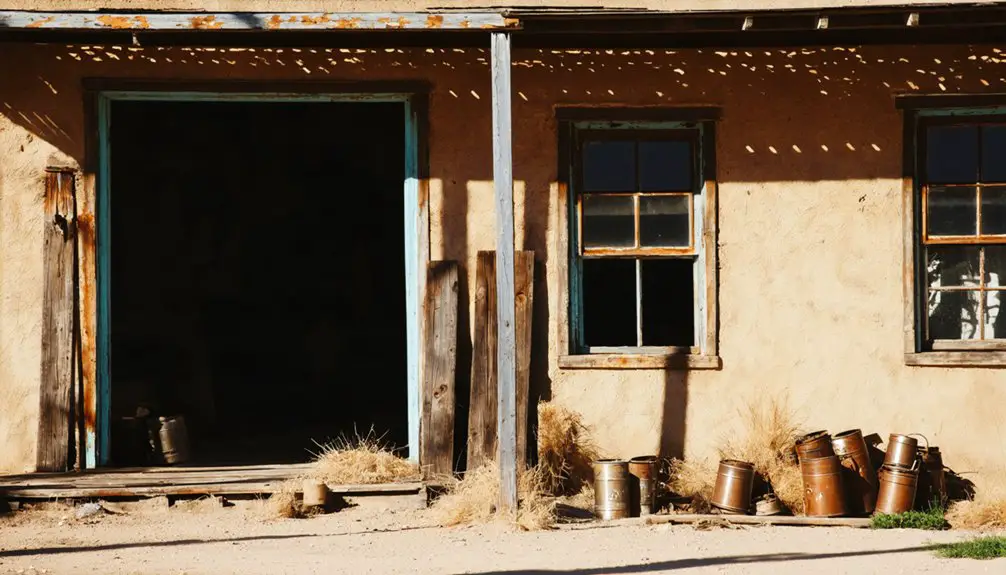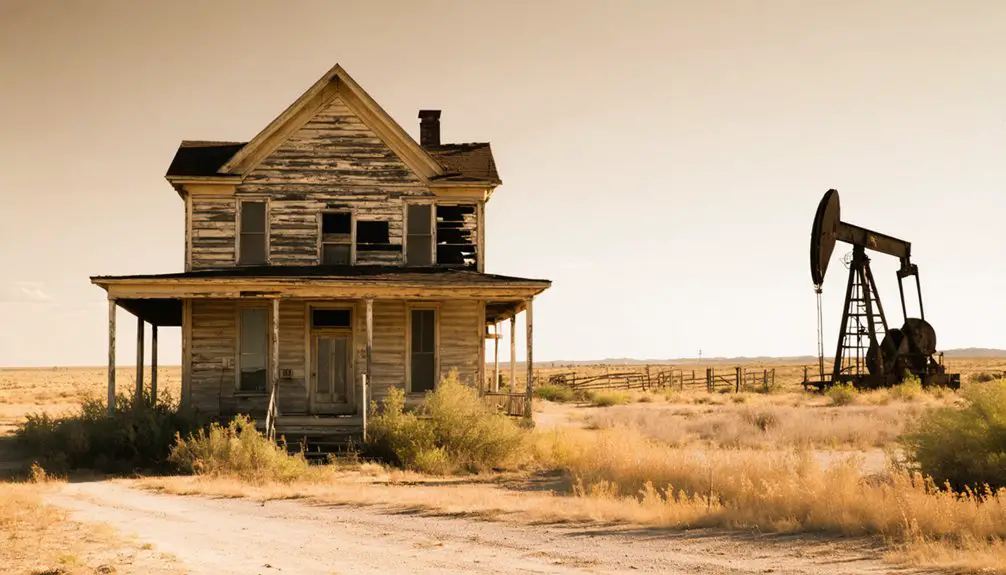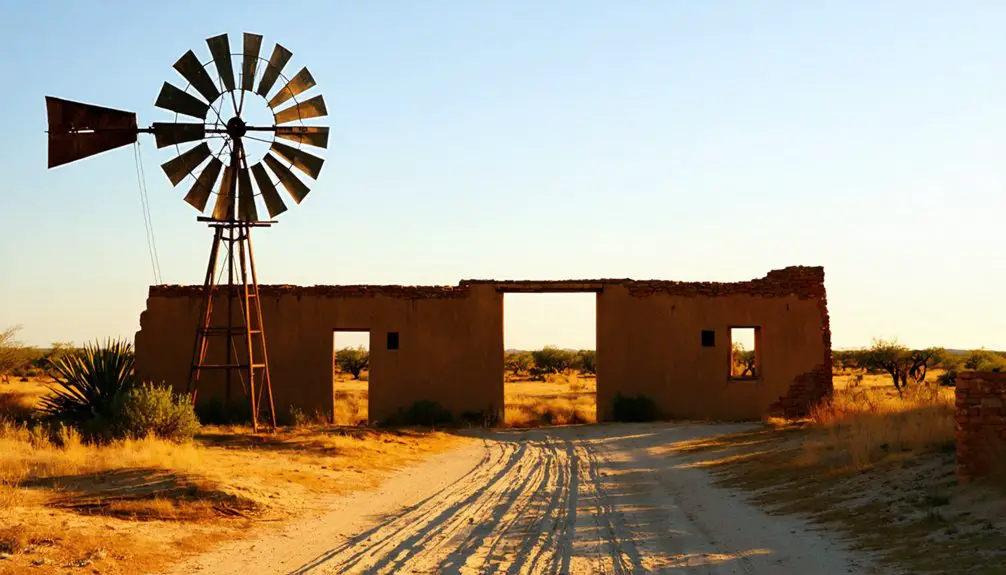You’ll find Chispa’s ghostly remains in West Texas, where it emerged as an essential railroad stop in 1882. The town’s strategic location and mercury mines made it an economic powerhouse, providing 40% of America’s mercury during WWI. Its diverse immigrant workforce shaped the area’s cultural heritage until the 1970s, when railroad closure led to its abandonment. Today, weathered ruins and mining structures tell fascinating tales of this once-thriving community.
Key Takeaways
- Chispa was established in 1882 as a railroad stop in West Texas, serving as a vital hub for workers and maintenance crews.
- The town’s only documented public service was a post office, which operated from 1895 until its closure around 1900.
- Chispa’s mercury mining operations contributed 40% of America’s mercury during World War I before the town’s eventual decline.
- By 1960, the population dropped below 100 residents due to railroad route changes, the Great Depression, and post-WWII urbanization.
- Today, Chispa exists as an abandoned ghost town with deteriorating foundations and no preserved buildings or historical markers.
The Birth of a Railroad Town
When the Rio Grande Northern Railroad began expanding its routes through West Texas in 1882, Chispa emerged as one of several strategic stops along the developing rail line.
You’ll find that this town’s establishment followed typical settlement patterns of the era, with the railroad creating new communities to support its operations across the frontier.
As railroad expansion pushed through the region, Chispa quickly became a crucial hub for workers, maintenance crews, and support industries. Like many historic sites across Texas that require community contributions today, the town played a vital role in preserving the era’s heritage.
The town’s strategic location along the 26-mile stretch between San Carlos made it an essential stop for both goods and passengers.
You can imagine the bustling scene as basic infrastructure sprouted up, including railroad sidings and housing for workers, all built from local materials to serve the growing community.
A coal mining spur connected the town to nearby mining operations along the Rio Grande, further cementing its importance as a transportation hub.
Life Along the Tracks
Life along the railroad tracks in Chispa painted a vivid picture of cultural diversity and physical determination. You’d have found Chinese laborers working alongside others, tackling grueling tasks like building massive earthen dams and stabilizing railbeds for track safety.
Chinese laborers toiled beside diverse workers in Chispa, united in their determination to construct dams and secure railroad tracks.
Their work camps moved frequently, following the progress of construction, though they’d settle longer when engineering projects demanded it.
You wouldn’t have found many permanent residents in this bustling yet transient community. Railroad labor dominated daily life, with workers coming and going as construction and mining operations demanded. The workers relied heavily on railroad signal towers to coordinate their movements and maintain safety along the tracks. The ambitious twenty-six mile line from Chispa to San Carlos represented the only portion of the railroad that was ever completed.
The town’s services remained basic, centered entirely around the railroad’s needs. When the coal mining venture proved unprofitable by 1897, you’d have witnessed the inevitable exodus of workers and the gradual emptying of Chispa’s streets.
Post Office Operations and Town Services
As Chispa’s population grew alongside its railroad activity in the mid-1890s, the town established its first and only documented public service – a post office.
You’d find this critical hub of community connection serving both railroad workers and coal miners from 1895 until its closure around 1900.
Like London’s historic Westcheap market, Chispa’s post office represented a central gathering point for the community, though on a much smaller scale.
The post office’s significance extended beyond simple mail delivery – it represented Chispa’s brief moment of official recognition and provided an essential link to the outside world.
You won’t find records of other municipal services like schools, churches, or stores during this period.
When the post office closed its doors after just five years, it marked a turning point in Chispa’s decline, following a pattern common to many Texas ghost towns whose fates were tied to single industries.
This decline mirrored the fate of towns like Santa Rita and other settlements that eventually became barren sites.
Early Community Development
You’ll find that Chispa’s earliest community formation centered around the railroad spur, where workers and their families established the first simple dwellings near the tracks in the early 1900s.
The initial homes, built from local materials and adapted to the harsh West Texas climate, created a foundation for the growing settlement as more residents arrived seeking mining and railroad work opportunities. Like in Thurber, the miners were issued monthly paychecks that limited their financial flexibility. The community spirit mirrored that of other frontier towns, with cotton farming becoming a crucial economic driver until the devastating boll weevil infestation of 1904.
These pioneer families, many of immigrant backgrounds, worked together to transform their collection of homes into a proper community, sharing resources and establishing informal support networks that would prove essential to the town’s early survival.
Railroad Spurs and Settlement
The establishment of Chispa’s railroad spur in 1882 marked the beginning of this Texas settlement’s brief but significant role in regional development.
As one of many railroad innovations of the era, the spur connected a local coal mine to the main rail line, transforming an empty stretch of west Texas into a bustling frontier community. Much like the old railroad supply road still visible today, these early transportation routes were crucial for moving resources and equipment. Similar to the industry spurs in East Waco that connected multiple rail lines, these connections were vital for local commerce.
You’ll find that railroad companies’ economic strategies shaped Chispa’s growth, as they frequently built spurs to tap into natural resources. The rail connection attracted miners, railroad workers, and merchants, leading to the town’s expansion.
Building the First Homes
Three distinct waves of settlers arrived in Chispa during the 1880s, building their homes from locally sourced timber and stone. You’d find these early pioneers constructing sturdy log cabins with hand-hewn walls and wooden shingle roofs, adapting their construction techniques to the harsh Texas environment.
As you’d explore the settlement, you’d notice how families positioned their homes strategically, considering access to water sources and protection from the elements. The construction process wasn’t easy – settlers often relied on their neighbors’ help to raise walls and set foundations.
Home materials were basic but functional, with stone or brick fireplaces serving as the heart of each dwelling. As more families arrived, they’d lay out 90-foot town lots, creating an organized community that centered around shared spaces and essential facilities.
The Decline Years

When Chispa’s post office closed around 1900, you’ll notice it marked the beginning of a swift population exodus from this once-promising railroad town.
You can trace the community’s economic collapse directly to its over-dependence on railroad activity, which diminished considerably in the early 20th century.
Without diversified industries or sustainable agriculture to fall back on, you’ll find that Chispa’s remaining residents gradually departed for more prosperous communities, leaving behind yet another West Texas ghost town.
Post-Railroad Economic Collapse
As Rock Island Railroad’s financial troubles mounted in the 1970s, Chispa’s economic foundation began to crumble irreversibly.
The community’s isolation became apparent when the railroad ceased operations in 1980, cutting off essential transportation links that had sustained local commerce for decades.
You’d have witnessed the rapid economic repercussions as supporting industries collapsed. Without rail access, local ranchers and merchants faced mounting shipping costs and dwindling business opportunities.
Tax revenues plummeted, leading to reduced municipal services. The town’s lifeline – its connection to regional markets and trade networks – was severed when new railroad owners focused on profitable main lines, abandoning Chispa’s branch line.
Jobs disappeared as railroad-related businesses shut down, triggering a chain reaction of closures that transformed this once-vibrant community into a ghost town.
Population Exodus Timeline
Since the town’s founding in 1882, Chispa’s population followed a steady downward trajectory that would span over a century.
You can trace the population trends through distinct phases, starting with early decline in the 1900s as railroad routes shifted away. The Great Depression accelerated the exodus, pushing farming families to seek opportunities elsewhere.
The most dramatic economic shifts occurred mid-century, when World War II and urbanization lured younger residents to cities.
By 1960, you’d find fewer than 100 people where hundreds once lived. The remaining population aged without replacement, and key institutions closed one by one.
Through the late 20th century, the town couldn’t compete with regional oil booms or highway development.
Ghost Town Status and Remains
Though once a bustling settlement in Jeff Davis County, Chispa now stands as a desolate ghost town in West Texas’s remote landscape. The ghost town characteristics are evident in its abandoned structures and deteriorating foundations, with few visible remnants of its former existence.
Chispa’s crumbling remains echo its vanished vitality, as desert winds sweep through abandoned foundations in this forgotten West Texas town.
You’ll find no preserved buildings or maintained historical markers at this isolated site.
Key preservation challenges you’ll encounter at Chispa include:
- Limited accessibility through unpaved roads and rugged terrain
- Lack of protective measures against weathering and vandalism
- Absence of historical documentation or restoration efforts
- Remote location requiring careful preparation for visitors
The site’s current condition reflects the harsh reality of many West Texas settlements that couldn’t sustain themselves after their economic drivers disappeared.
If you’re planning to explore Chispa, you’ll need to be self-sufficient and prepared for its isolated desert environment.
Historical Impact on West Texas

When the Chisos Mining Company established operations in early 1900s Chispa, the settlement became a catalyst for West Texas’s economic and social transformation.
You’ll find that Chispa’s quicksilver production contributed 40% of America’s mercury during World War I, positioning the region as an essential resource hub.
The town’s mining legacies extend beyond economics. You can trace how immigrant workers shaped the area’s cultural heritage, creating a diverse community that flourished during the boom years.
The development of roads, postal services, and trade networks connected isolated communities, while the flow of goods and people reshaped the region’s infrastructure.
Though Chispa’s decline mirrored the fate of many mining towns, its impact on West Texas’s development, demographics, and cultural identity remains significant, marking a pivotal chapter in the area’s history.
Legacy and Tourism Potential
Today, Chispa’s weathered ruins stand as compelling reminders of West Texas’s mining heritage, drawing history enthusiasts and adventure seekers to its remote location.
You’ll find untapped potential for heritage preservation through sustainable tourism development, though challenges like accessibility and infrastructure needs must be addressed.
Key opportunities for tourism marketing include:
- Developing marked trails and guided tours through original mining structures
- Creating educational programs focused on immigrant worker contributions
- Organizing seasonal festivals celebrating mining culture
- Establishing partnerships with regional tourism boards
You can explore Chispa’s authentic character while contributing to local economic growth through responsible tourism.
The ghost town’s proximity to natural landscapes offers unique opportunities for combining outdoor adventures with historical exploration, making it an ideal destination for those seeking off-the-beaten-path experiences.
Frequently Asked Questions
Were There Any Notable Crimes or Lawmen Associated With Chispa?
Drawing a blank, you won’t find notable criminals or law enforcement stories from Chispa. Records show no major crimes, and as a small mining camp, it didn’t attract significant law enforcement attention.
What Native American Tribes Lived in the Area Before Chispa’s Founding?
You’ll find the Chisos, Jumano, Tobosos, and Coahuiltecan peoples shaped the cultural influence of this tribal territory, while Lipan Apache bands later moved through the region’s desert landscapes.
Did Any Famous People Ever Pass Through or Stay in Chispa?
You won’t find any famous visitors or historical figures associated with this mining camp. The records show it was primarily populated by local miners and workers without any documented celebrity appearances.
What Was the Highest Recorded Population of Chispa During Its Existence?
You won’t find exact population records in Chispa’s history, but based on comparable railroad towns and population growth patterns, historians estimate its peak was likely between 200-400 residents during its railroad heyday.
Were There Any Schools or Churches Established in Chispa?
You won’t find any confirmed school history or church influence in historical records. While nearby mining towns had these institutions, there’s no evidence of formal schools or churches in this location.
References
- https://www.tshaonline.org/handbook/online/articles/htc06
- https://en.wikipedia.org/wiki/List_of_ghost_towns_in_Texas
- https://www.texasescapes.com/TexasGhostTowns/ChispaTexas.htm
- https://urbexunderground.com/ghost-towns-in-texas/
- https://www.texasescapes.com/TOWNS/Texas-Ghost-Towns-2-Central-Texas.htm
- https://www.texasescapes.com/TOWNS/Texas-Ghost-Towns-4-West-Texas.htm
- https://www.simplytexan.com/truly-texan/abandoned-ghost-towns-in-texas/
- https://www.texasstandard.org/stories/when-lobos-water-dried-up-it-took-the-west-texas-town-with-it/
- https://mix931fm.com/10-texas-ghost-towns/
- https://www.texasescapes.com/TOWNS/Texas_ghost_towns.htm



